|
|
|
|
|
CRUFFLER.COM
presents
FIREARM
REVIEW,
November
2001:
|
|
|
|
Type: Straight Pull Bolt Action Rifle Chambering: 7.5x55mm Capacity: 6 round detachable box magazine Sights, front: Windage adjustable blade Sights, rear: Tangent leaf adjustable to 1,500m Length: 43.6" Barrel length: 25.65", 4 grooves RH twist Weight (unloaded): 8.85 Cruffler Price: $179.95 |
INTRODUCTION
There is an
apocryphal story of a visit paid to Switzerland by Kaiser Wilhelm II in
the early part of the twentieth century. Upon his arrival, he was
met by an honor guard of Swiss troops at the railway station in Zurich.
Among the impeccably uniformed troops that comprised the honor guard was
a crusty old sergeant-major. As he reviewed the troops, the Kaiser
paused in front of the sergeant major.
"Is it not a wonder, sergeant-major, that the might of the German Empire is such that the numbers of our standing army are double that of your army, even with all your reserves activated?"
The sergeant-major immediately responded: "Jawohl, your majesty, it is such a wonder!"
The Kaiser prodded the sergeant-major a bit further.
"So what do you think should happen if we were to invade your country, with an army twice the size of yours?"
The sergeant major thought about this for a little bit, and responded.
"Then, your majesty, we should all have to fire our rifles twice!"
While the story is an amusing historical anecdote, the deadly earnestness with which the Swiss took their neutrality and their longarms was no laughing matter. The rifles the sergeant-major alluded to were none other than those based on the Schmidt-Rubin design that armed Switzerland from 1889 until the early 1960's.
The Schmidt-Rubin design dates from the very beginning of the smokeless powder era. Eduard Rubin developed the first successful small caliber jacketed bullets capable of withstanding velocities greater than 2,000 feet per second without shedding their jackets in the bore. Rubin cartridges of between 8.1mm and 9.6mm were tested against a Hebler pattern 8.6mm cartridge by the Swiss in 1882. While the Hebler cartridge (which had a papier-mache core) attained amazingly high velocities, but was markedly inferior in accuracy to the Rubin cartridge. The Rubin cartridge was eventually adopted by the Swiss in 7.5mm and 8mm calibers.
Taking advantage of the new ammunition was Rudolf Schmidt. Schmidt submitted a straight pull bolt action rifle in 1885. The rifle used an actuating rod set into a channel on the right side of the breech to rotate the bolt through a helical channel cut in the bolt sleeve. Twin lugs were provided midway along the bolt sleeve, and these locked into recesses in the receiver directly above the trigger. With some modifications, the Schmidt-Rubin, chambered for the 7.5x55mm Rubin cartridge, was adopted four years later by the Swiss as the Infanterie-Repetier- Gewehr M1889.
By 1930 it had become evident that the Schmidt action would require significant modifications if it was to keep abreast with advances in ammunition technology. Consequently, on January 22, 1932, the Bundesrat (the Swiss parliament) approved the manufacture of about 20 experimental short rifles. The experiments were successful, and the Karabiner 31 (K31) was adopted on June 16th, 1933. The K31's action had been dramatically improved over the original Schmidt design. While it remained true to the original Schmidt operating principles, the K31's action differed greatly in detail. Instead of locking into the receiver behind the magazine well, the K31's locking lugs mated with recesses in the receiver ring. Additionally, the bolt did not extend past the end of the bolt sleeve, reducing receiver length by some 2.4". A 25.65" barrel, slightly longer than that of the earlier K11, but some five inches shorter than the G11 rifle was fitted, as was an improved rear sight. The K31's proved to be robust and reliable in Swiss service, and were also noted for their fine accuracy. Military production ceased in 1958, with some 582,230 being produced.
Recently, many of these rifles have become available on the US surplus market at low prices that belie their fine craftsmanship and expensive machining. Taking advantage of our severe medical condition (we have a physical inability to turn down a fine rifle at a a low price) Bryan Flanagan of Springboro, Ohio based AIM Surplus, made the availability of the K31's known to us. Not surprisingly, we broke down and ordered one. (Editor's note: The gang should be very proud of their willpower here - they must have held out for nanoseconds before saying "OK, send it!") A few days later the BBT arrived, bearing the tell tale long brown cardboard box.
PRODUCT REVIEW
External Inspection
|
Checking the headspace dimension on a Schmidt-Rubin can be a bit of a challenge, as neither of the major gauge manufacturers (Clymer and Forster) offers gauges for the 7.5x55mm as a standard item. However, Clymer Manufacturing will manufacture a set of specialty gauges in any desired caliber at a cost of $45.00 per gauge. We ordered a complete set of sing a set of 7.5x55mm headspace gauges from Clymer Manufacturing in the GO (1.8086"), NO-GO (1.8146") and FIELD (1.8186"). It is worth noting that the neither 7.5x55mm ammunition nor the headspace gauges are made to specifications laid down by the US based Sporting Arms and Ammunition Manufacturer's Institute (SAAMI). Rather, the specifications are those set by the Commission Internationale Permanente (CIP). In Europe, proof houses or testing facilities for firearms and ammunition, have set European standards since the 1800s. The CIP is an international association of proof houses. That being said, it is also worth noting that the CIP and SAAMI are working towards the development of international standards with the goal of interchangeable SAAMI and CIP standards.
K31 Bolt Disassembly Sequence
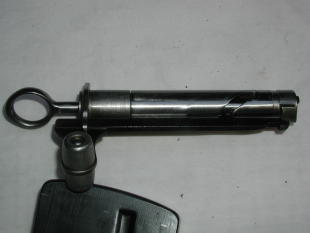
Bolt as removed from the receiver |
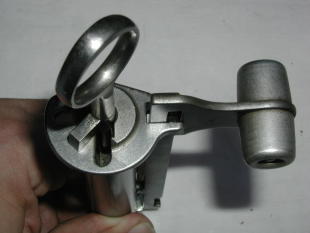
Striker pulled to the rear and twisted 45 degrees to remove spring tension |
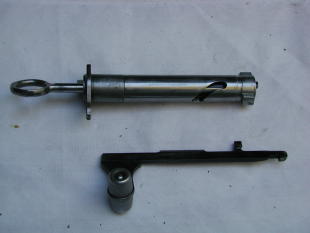
Operating rod removed from the bolt |
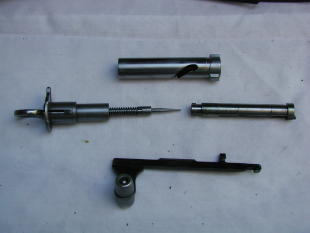
Striker housing uncoupled from bolt, to rear, allowing removal of bolt and striker housing from bolt sleeve |
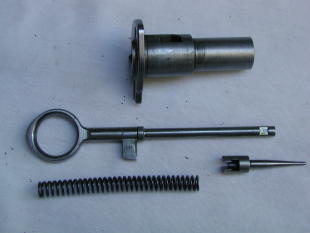
Striker housing unit disassembled |
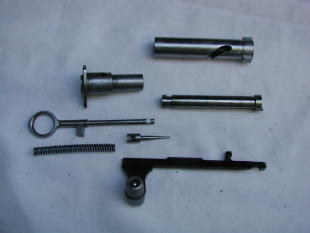
Disassembled bolt unit |
| Next,
we detail stripped the bolt. At first glance, this might seem to
be a daunting task, but in retrospect the K31's bolt is no more complex
than that of the the Mauser 98. Disassembly and reassembly are described
in the sidebar accompanying the text. We were not at all disappointed
with what we found. The insides of of the bolt were as pristine as
the inside of the bore, looking for all the world as though it had just
rolled off the production line. All in all, it was very hard to be
disappointed with the condition of the rifle.
The K31 is
marked with a serial number on the left side of the receiver, which is
repeated on the bolt and on the bottom of the six round detachable box
magazine. The barrel shoulder, where it abuts against the forward
edge of the receiver is marked with the last three digits of the serial
number as well as a number of proof, inspection and acceptance marks, which
are detailed below. There is a large Swiss cross engraved on the
top of the receiver.
For the historian, the K31 offers a special treat. Underneath the buttplate one will usually find a small piece of paper. On this slip is written the last three digits of the serial number as well as the name, rank, birth year, unit designation, and home address of the Swiss soldier to whom the rifle in question had been issued. Our K31 was no exception, and upon removing the buttplate, we found a slip of white waterproof paper, with a hole punched so as to allow the lower buttplate screw to keep it in place. On it was neatly typed:
|
|
||||||||||||||||||||||||||||||||||||||||||||||||||||||||||
|
|
Shooting
the K31
Swiss rifles
have achieved an enviable reputation for accuracy. We
were, in no small way, excited to go test the K31. And so, with a
yodel in our hearts, rosti in our bellies, we packed our range bags and
headed off to the Alpine climes of the NRA
range in Fairfax, Virginia. (Or at least as Alpine as Northern Virginia
gets. . . )
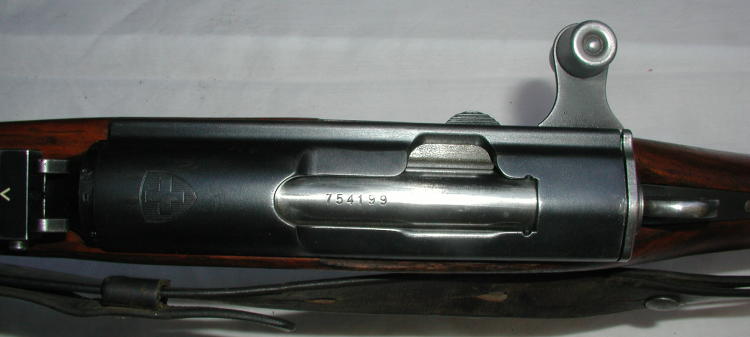 |
We brought along both the Norma and the INDEP ammunition with which to test the K31
Accuracy
Targets were
both 3" black centers and 1" orange dots set at the range's maximum distance
of 50 yards. As expected, the mean point of impact for all groups
fired was slightly high owing to the minimum sight setting of 100 meters.
Despite this, the group sizes were gratifyingly small, and, if seeing is
believing, definite proof of the adage "You get what you pay for."
Three five shot groups were fired for each ammunition type, and measured.
The center to center group sizes ranged between a stunning 0.5" and about
1.25". The best results for each ammunition type are indicated below:
|
|
|
| INDEP 170 grain FMJ | 1.25" |
| Norma 180 grain softpoint | 0.5" |
The test group was simply stunned by these results. The K31 had displayed a level of accuracy unseen in previous reviews, and inspired at least one member to purchase a K31 on the spot. We weren't the only ones impressed with the combination of Norma ammunition and the K31. At least two other shooters were seen staring incredulously at the K31's groups and then slowly turning back to their own rifles (a DSA SA58 and a Bushmaster AR-15) shaking their heads. It was, in all senses, a delicious moment to be a Cruffler.
Recoil and
Ergonomics
Recoil was
stiff, but not unpleasant and about on par with the 7.92mm Mauser or .30
M2. The K31's wide, flat buttplate did an excellent job of distributing
the recoil forces over a large area. The pistol grip stock filled
the hand comfortably, and the angle of stock is such that that the head
aligns naturally with the line of sight. The stock has a few other
nice touches. Among these are the offset grasping grooves.
The grasping groove on the right side is beneath the forward end of the
receiver, while the groove on the left side is beneath the rear sight.
The rationale for this arrangement becomes apparent when one hefts the
rifle - the four fingers of the left hand slip easily into the right side
grooves, while the thumb falls naturally into the left groove. The
straight pull action is an absolute joy; rapid and exceedingly smooth.
Perhaps the only negative aspect about the action is that the rear of the
cocking piece comes perilously close to one's nose when the bolt is manipulated
rapidly!
Reliability
The K31 exhibited
no failures to feed, fire, extract or eject.
Conclusion
The K31 is
a fascinating rifle from a number of perspectives. Not the least
of these is the economic. It has
|
been estimated that were the K31 to be produced today for commercial consumption, to a comparable level of quality, fit and finish as the original Swiss military rifles, the wholesale cost would be in excess of $2,500.00. Examine a K31, its easy to see why. The machine work is exquisite and the mating of metal to metal and metal to wood displays a craftsmanship, pride and care that are simply not seen anymore. Accuracy is among the best of any military rifle we've ever seen. At $179.95, it's an excellent value, and a wonderful example of old world craftsmanship. With surplus ammunition on the way, it's hard to justify NOT buying one! |
|
For more information
on purchasing a K31, contact AIM Surplus
at 513-424-9960.
And now, our
Buy-O-Meter rating for the Swiss K31 from AIM Surplus:
 |